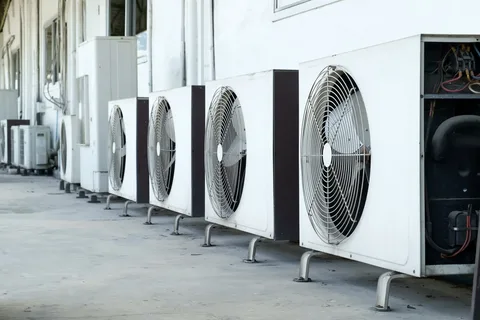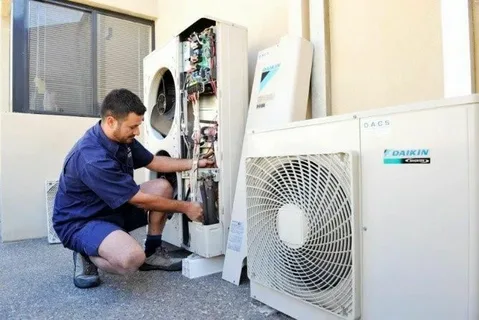Residential Air To Air Heat Exchanger is a great way to reduce energy bills and make your home more energy efficient. Heat recovery air exchangers are designed to capture the warm air produced inside your home, and then use it to pre-heat the incoming air from outside. They’re becoming increasingly popular among homeowners looking to reduce their energy costs and lower their carbon footprints. In this ultimate guide to heat recovery air exchangers, we’ll explain how they work, the different types available, and how to choose the best one for your home.
What is a Home Air Heat Exchanger?
A Home Air Heat Exchanger, also known as a heat recovery ventilator (HRV) or an energy recovery ventilator (ERV), is a device that improves indoor air quality by removing stale air and replacing it with fresh, filtered air.
HRVs and ERVs work by extracting heat and moisture from the air that is being exhausted from a home, and transferring it to the incoming fresh air. This process not only saves energy by reducing the load on heating and cooling systems, but also helps maintain a comfortable indoor temperature while ensuring adequate ventilation.
In colder months, HRVs warm the incoming air using heat from the outgoing air, while in warmer months, ERVs cool the incoming air by transferring the heat from the incoming air to the outgoing air.
Overall, heat recovery air exchangers are a valuable addition to any home, particularly in climates with extreme temperatures, high humidity, or poor outdoor air quality. They improve indoor air quality and promote energy efficiency, helping homeowners save on their energy bills and reducing their carbon footprint.
How does Heat Recovery Air Exchanger work?
Heat recovery air exchangers work by transferring heat energy from the outgoing stale air to the incoming fresh air, without mixing the two air streams. The Heat Recovery Air Exchanger system uses a heat exchanger core made up of thin metal plates that alternate between the two air streams.
When the stale air is expelled from the home, it passes through one side of the heat exchanger core and gives off its heat energy to the plates. Meanwhile, fresh air from outside is drawn through the other side of the core, picking up the heat energy from the plates as it enters the home.
 The two air streams never mix, so the fresh air entering the home remains pure and uncontaminated, while still being preheated by the outgoing stale air. This process reduces the energy needed to heat or cool the fresh air, thereby saving on energy bills.
The two air streams never mix, so the fresh air entering the home remains pure and uncontaminated, while still being preheated by the outgoing stale air. This process reduces the energy needed to heat or cool the fresh air, thereby saving on energy bills.
Heat recovery air exchangers can recover up to 90% of the heat energy from the outgoing stale air and use it to warm up the incoming fresh air, making them an effective and energy-efficient solution for ventilation and indoor air quality.
What are the benefits of Heat Recovery Exchanger?
Heat recovery air exchangers offer numerous benefits for residential homes. These include:
- Improved indoor air quality: Heat recovery air exchangers help to circulate fresh, clean air into your home while removing stale, contaminated air. This Heat Recovery Exchanger can greatly improve indoor air quality and reduce the risk of health problems caused by poor air circulation.
- Energy efficiency: Heat recovery air exchangers help to maintain a constant temperature in your home by using the outgoing air to heat or cool incoming air. This means that your HVAC system doesn’t have to work as hard to keep your home at a comfortable temperature, resulting in lower energy bills.
- Reduced carbon footprint: By using the energy in outgoing air to heat incoming air, heat recovery air exchangers reduce the amount of energy required to heat or cool your home. This reduces your carbon footprint and helps to protect the environment.
- Comfort: Heat recovery air exchangers help to maintain a comfortable, consistent temperature throughout your home, reducing hot and cold spots.
- Noise reduction: Heat recovery air exchangers are designed to operate quietly, so you won’t even notice them running.
Overall, heat recovery air exchangers offer a range of benefits that make them a smart choice for residential homes. By improving indoor air quality, reducing energy bills, and reducing your carbon footprint, heat recovery air exchangers can help you to create a comfortable, healthy, and environmentally friendly home.
How to choose the right Residential Energy Recovery Ventilator for your home
When it comes to choosing the right heat recovery air exchanger for your home, there are several factors you should consider. Here are some of the key considerations to keep in mind:
- Capacity: Make sure you choose Residential Energy Recovery Ventilator that is the right size for your home. A unit that is too small won’t be able to effectively exchange air, while a unit that is too large will be wasteful and inefficient.
- Energy efficiency: Look for air exchangers with high energy efficiency ratings, such as those with an Energy Star certification. These units are designed to consume less energy while still providing effective air exchange.
- Maintenance requirements: Consider the maintenance requirements of different models. Some air exchangers require regular filter changes, while others may require professional servicing.
- Noise level: Heat recovery air exchangers can be noisy, especially if they are installed in a living area. Look for models with noise-reducing features or consider locating the unit in a less-trafficked area.
- Additional features: Some heat recovery air exchangers come with additional features, such as programmable controls or automatic shut-off when air quality levels are poor. These features can improve the efficiency and effectiveness of the unit.
- Installation requirements: Consider the installation requirements of different models. Some units may be easier to install than others, while some may require professional installation.
By considering these factors and doing your research, you can choose the right heat recovery air exchanger for your home and enjoy all the benefits of improved indoor air quality and energy efficiency.
How to install Residential Heat Recovery Systems
Once you’ve chosen the right Residential Heat Recovery Systems for your home, the next step is to install it properly. Although the installation process may seem daunting, with a little preparation and guidance, you can successfully install a heat recovery air exchanger yourself. Here are the basic steps:
- Determine the best location for your unit: The best location for your heat recovery air exchanger depends on a number of factors, including the size of your home, the layout of your ductwork, and the climate in your area. Generally, it’s best to install the unit in a central location where the fresh air supply and exhaust vents can easily be connected to your existing ductwork.
- Prepare the installation area: Before installing the heat recovery air exchanger, make sure the installation area is clean and free of obstructions. Remove any debris, insulation, or other materials that may interfere with the installation process.
- Connect the fresh air supply and exhaust vents: The fresh air supply and exhaust vents are typically located on the exterior of your home. Use ductwork to connect these vents to the appropriate ports on your heat recovery air exchanger.
Install the Residential Heat Recovery Ventilator unit:
- Once the vents are connected, mount the heat recovery air exchanger on the wall using the mounting brackets provided with the unit. Make sure the Residential Heat Recovery Ventilator unit is level and securely mounted before proceeding.
- Connect the ductwork: Next, connect the ductwork from your existing ventilation system to the appropriate ports on the heat recovery air exchanger. Be sure to follow the manufacturer’s instructions carefully to ensure proper installation.
- Test the unit: Finally, test the heat recovery air exchanger to make sure it is working properly. Turn on the unit and check the air flow in each room of your home. Make any necessary adjustments to the settings or ductwork to optimize the performance of your new unit.
By following these basic steps, you can successfully install a heat recovery air exchanger in your home. However, if you’re unsure about any part of the installation process, it’s always best to consult with a professional HVAC technician for assistance. With a little time and effort, you can enjoy the many benefits of improved indoor air quality and energy efficiency with your new heat recovery air exchanger. If you’re unsure about any of the steps, don’t hesitate to refer to the installation manual provided by the manufacturer. This will ensure that you follow the correct procedure and that you don’t void your warranty by installing the unit improperly.
It’s also important to note that the installation process can vary depending on the type and model of the heat recovery air exchanger you choose. Some models may require additional steps or components, such as a condensate drain or a bypass damper. Be sure to research the specific unit you’re installing and follow the manufacturer’s instructions carefully.
In addition to proper installation, it’s important to maintain your heat recovery air exchanger to ensure optimal performance. This may include regular filter changes, cleaning of the core, and inspection of the ductwork. By taking good care of your unit, you can prolong its lifespan and enjoy the benefits of improved indoor air quality and energy efficiency for many years to come.
Conclusion
Heat recovery air exchangers offer an effective way to ventilate and heat your home, while also helping you to save on energy costs. With so many options on the market, it’s important to choose the right one for your specific needs. Whether you’re looking for a residential air to air heat exchanger, a home air heat exchanger, or a residential energy recovery ventilator, there’s sure to be an option that works for you. By taking the time to research and invest in the right heat recovery air exchanger, you’ll enjoy a more comfortable and energy-efficient home.

